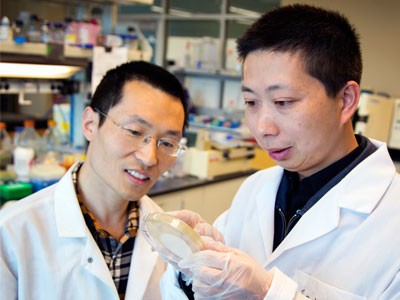USU Researcher Uses Bacteria to Synthesize Compounds Found in Plants
Dr. Jixun Zhan and Shuwei Zhang inspect a sample of E.coli at the Metabolic Engineering Lab on the USU campus in Logan. Zhan and his team have developed a new method to synthesize natural plant compounds using bacteria.
A researcher at Utah State University is developing a cutting-edge method for synthesizing some of the most promising natural compounds found in plants using bacteria.
Jixun Zhan, associate professor of biological engineering, recently published new research in the Journal of Metabolic Engineering showing how various bioactive compounds can be biosynthesized using Escherichia coli. The journal is one of the most highly regarded in the biological engineering community.
The findings are a breakthrough in the growing field of combinatorial biosynthesis, and demonstrate that valuable, health-promoting compounds can be produced without the time-consuming methods of conventional plant cultivation.
Zhan and his team analyzed several metabolic pathways in plants to understand how they create a range of natural products and then constructed artificial biosynthetic pathways in a bacterial host to create multiple compounds including resveratrol and curcumin — two compounds that show several promising health-promoting properties.
“In this work, we demonstrated that biosynthetic enzymes from different sources can be recombined like Legos to make various molecules,” writes Zhan in his latest publication, “Metabolic engineering of Escherichia coli for the biosynthesis of various phenylpropanoid derivatives.”
Resveratrol — a type of natural phenol found in the skin of grapes, blueberries, raspberries and peanuts — has antioxidant, anti-inflammatory and anticancer properties and is used as a nutritional supplement. Curcumin — the major active component in turmeric — has been shown to be effective at treating allergies, asthma, cancer and Alzheimer’s disease.
Zhan’s team constructed a library of eight enzymes for combinatorial biosynthesis and created 12 bioactive molecules using E. coli. With different combinations of these biosynthetic tools, he explained, a variety of pathways can be established to yield desired products including some novel compounds — many of which can play a role in the development of new drugs and existing pharmaceutically important compounds.
In addition to synthesizing plant “natural” products in E. coli, Zhan also generated novel “unnatural” structures that plants cannot produce, such as halogenated derivatives of resveratrol.
Halogenated compounds account for nearly a quarter of current drugs or those in the development pipeline. The discovery or synthesis of new halogenated molecules is important for drug development. In this work, by combining enzymes from plants, bacteria and fungi in E. coli, Zhan’s team synthesized a novel halogenated resveratrol derivative — 2-chloro-resveratrol — which has stronger antioxidant and antimicrobial activity compared to the natural product resveratrol.
This combinatorial biosynthesis approach provides an effective tool to create novel molecules that do not exist naturally.
Related links:
USU Department of Biological Engineering
Contact: Jixun Zhan, 435-797-8774, Jixun.Zhan@usu.edu
Writer: Matt Jensen, 435-797-8170, matthew.jensen@usu.edu
Comments and questions regarding this article may be directed to the contact person listed on this page.








